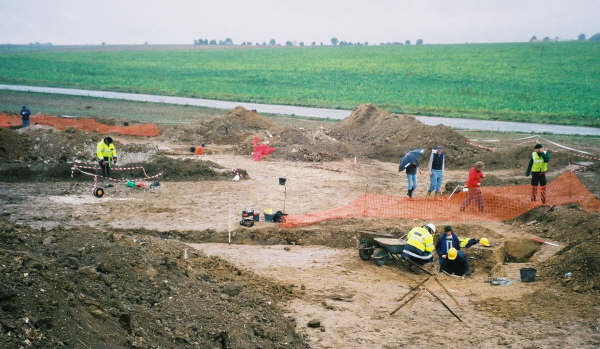
General view of the site
LOOKING FOR WILFRED
Archaeological Excavations at Serre, Somme
No Man's Land conducted excavations on the site of German trenches at Serre on the Somme in October 2003 for the BBC TV programme Ancestors.
The Plan
General view of the site
The fills of the two sections of trench were surprisingly different. Area 1 showed a series of large, relatively deep deposits, including a thick chalk layer, while Area 2 revealed a multi-layered series of mixed, narrow fills. In both areas a succession of slumped deposits visible in section indicated constant erosion and maintenance until the point at which the trench was abandoned, when it would have filled more rapidly. The final stage in the process was usually the arrival of those attempting to restore and reclaim the land. However as excavation proceeded in this area it became apparent that all was not as simple as it seemed. As we were able to show Area 1 was subject to partial infilling by a single event.
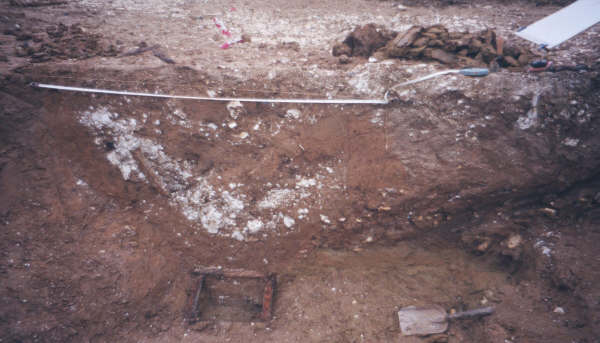
Section with
rubble
In addition to the work on the trench sections the surface of the area around was cleaned, revealing a number of features including a portion of one of four in-filled mine craters. The mines were blown by the Germans to disrupt the British attack on the 1st July 1916, the start of the Battle of the Somme. No archaeological investigation of the mine was undertaken in case we bit off more than we could chew in terms of materiel and human remains, as a crater seemed an ideal place to dump lots of stuff.
The Combat
Human remains were uncovered in Area 1. These turned out to be a British soldier
whose insignia revealed him to be from the Kings Own (Royal Lancaster) Regiment.
The 1st Battalion of the King’s Own was part of attack on the Heidenkopf
in the first hours of the Somme battle. His position on the top of the chalk
layer was significant, giving a relative date to the fill, showing it was not
post-war battlefield restitution but more likely redeposited natural material
cast into the air by the detonation of the mines. The presence of British casualties
in the trench shows that attempts to disrupt the attack were only partly unsuccessful,
as some of them reached the Heidenkopf. A succession of trench boards lain one
on top of the other was found beneath the chalk: as each successive section
sank into the mud a new one was thrown down. What did surprise us was the poor
quality of the trench. It was neither deep nor well constructed; not demonstrating
the strength usually associated with German trenches. It appears the Germans
decided that the Heidenkopf was useful but not particularly defensible; it was
a salient feature and was overlooked, so it attratced a lot of enemy fire. It
seems that the Germans decided that constant maintenance of well-constructed
revetments would be of debatable value but occupation was strategically important.
To the rear of Area 1 number of smaller features were revealed and were investigated.
One shallow scrape was found to contain remains of a German soldier, while another
revealed a large, unexploded howitzer shell.
Area 2 showed significant evidence of combat. There was shell damage evident
in the rear of the trench but it was also possible to see the evidence of close
combat. Fired cartridges and both full and empty magazines from a British Lewis
light machine gun showed that there had been fighting along the trench. These
remains were found on a traverse (bend) in the trench by a cheveaux-de-frise,
or trench barricade, made of angle irons and barbed wire. This example had beento
have been pulled down into the trench to impede the British advance, while the
magazines suggest that a machine gun was set up in a classic position to cover
enemy held positions. Coincidentally one of Owen's letters to his mother mentions
the loss of a Lewis Gun by another officer in this area.
A feature in the front edge of the trench raised hopes that we had located a dugout entrance as an entrance shaft was uncovered. However investigations revealed it to be the top of a mineshaft, probably associated with the digging of the mine tunnels in which the charges were laid. The opening of the feature was investigated but safety considerations made further investigation impossible. This area also showed evidence of the post-war reconstruction. Closer examination of the stratigraphy showed how the trenches were back-filled as the French returned to their devastated farms. The mixed stratigraphy observed in Areas 2 seems to show the dumping of spoil back into the former fortifications. A small extension to the working area was opened, at the insistence of the BBC, in case anything looking like the elusive dugout could be seen. Once again topsoil was stripped and we exposed the line of the trench. However the discovery of a third body, again laid in a s!hallow depression diverted attention from other features, as I took the decision that human remains had to take priority because it was a person we had disturbed.
The Fallen
Thousands are still missing on the Somme. During this project we found three
sets of human remains: two German and one British.
Skeleton 1 was a German. Careful excavation found not only a few personal effects but also a badly corroded identity disc, conserved courtesy of University College London. This disc had been amended by its owner and a few scratched fragments of a name helped us identify him.
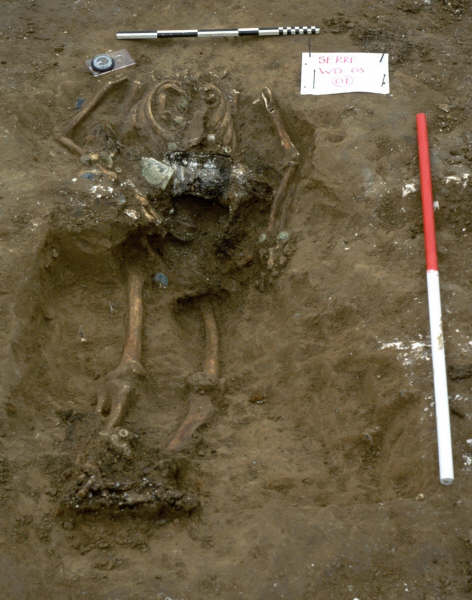
Skeleton 1
Skeleton 2 was found lying extended on top of the chalk fill of the front trench of the Heidenkopf. Cause of death was a shell-burst, demonstrated by the numerous small shell fragments amongst the bones and the serious fracture to the right femur, a common blast-related injury. Some attempt at burial may have been made; the screw picket beside the body may have served as a temporary grave marker. However the body was sufficiently accessible to have attracted rats, whose burrows could still be seen in the abdominal area, underlining the realities of trench warfare. The skeleton still had remains of uniform, gas mask, candles and other pieces of material equipment, as well as a purse containing French, English and Channel Islands coinage. This latter currency is of interest as it suggests the body to have been a regular soldier, based on information that the 1st Battalion, The Kings Own had been on garrison duty in the Channel Islands immediately! prior to the outbreak of war. He lies in Serre Number 2 military cemetery.
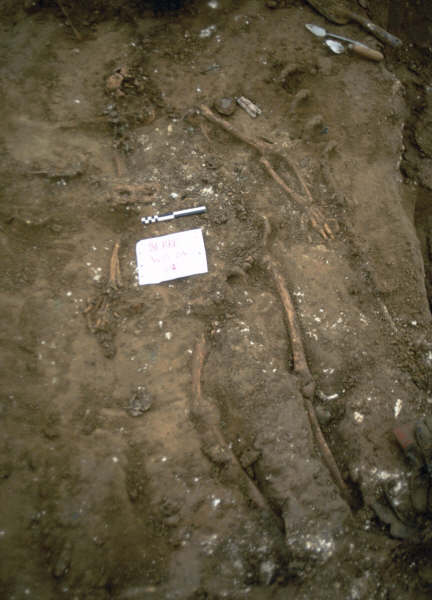
Skeleton 3 had also been the subject of minimal disposal, lying on one side again in a hollow. No attempt had been made to remove personal effects from the body to the extent that his Bread Bag, with numerous contents lay beside the skeleton. Examination of the contents revealed a pocket watch, razor, penknife, pipe and a roll of papers, shown by UCL to be a bankbook. Other contents of the bag had, perhaps, been edible and been eaten by maggots, as a compressed mass of blowfly casts was noted. The bag also contained a nice example of a later Prehistoric flint scraper. So far no identification of this skeleton has been reached though efforts are proceeding, which point to Alfred Thielecke, an NCO of 7 Kompanie, 121 RIR. He was killed in action on 11th June 1915.
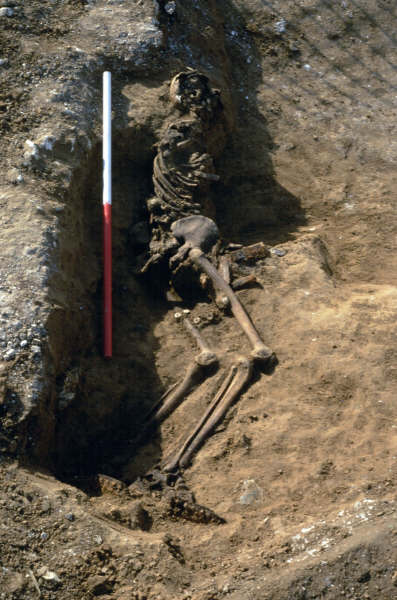
Skeleton 3
Finding Private Hönes
Skeleton 1 was buried with his identity disc, still wearing his uniform and
webbing. The only official information on ID discs was the regimental designation
and number, the number of the company and the number of the individual on the
company roll. This disc showed that the man served with a reserve infantry regiment
but unfortunately the number was missing; he was in 7 Kompanie and was number
2 on their roll. It was known that 7 Kompanie of 121 Reserve Infantry Regiment
were in the trenches at Serre from 10th to 13th June 1915. At this time there
was heavy fighting with the French and it was possible that the soldier had
been killed during this engagement. They were not in that area on 1st July 1916,
which was the other period of heavy fighting (first day of the Battle of the
Somme) when one might expect unrecovered casualties. We believe the owner was
uneasy about the lack of a name on his iden!tity disc, as he had scratched some
details on the reverse with a knifepoint or something similar. The corrosion
had removed some of the legend but it was possible to read the top line as "Mun
…", the second line as “Hines”, and the bottom line “Jak
…”. The difficulty was in deciding what this meant. However we were
coming closer to identifying his unit. The arrangement of the buttons on the
cuff was of the "Swedish" pattern. This style was not uncommon in
the Imperial German Army but significantly was used by a number of Wurttemberg
infantry regiments. This sector was occupied from March 1915 to November 1916
by 26 Reserve Division, a Wurttemburg formation. It was found that the only
regiment in 26 Reserve Division that wore Swedish cuffs was 121 Reserve Infantrie
Regiment. A search of casualty lists for this unit in June 1915 revealed the
loss of Jakob Hones (the I in "Hines" on the dis!c actually being
an O with umlaut), a farm labourer from Munchingen near Stuttgart. His geographic
origins were underlined by the lid from a polish jar sold by a Stuttgart department
store associated with the skeleton. Further researches produced a Hones family
still in the area, including the Jakob's last surviving son. Skeleton 1, now
reunited with family and name, rests today in the German military cemetery near
Metz (Fraser 2004).
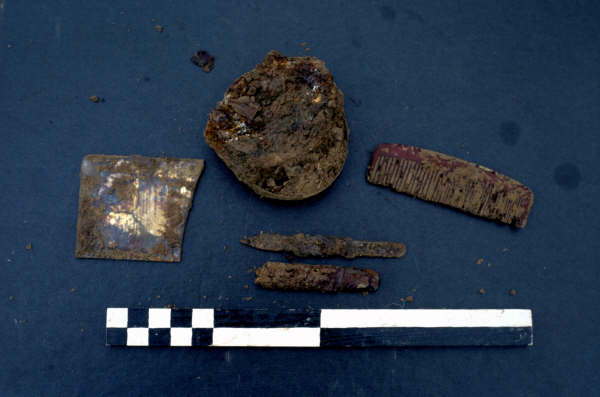
Jakob's effects
This was once a Man
One aspect of this work has been to consider the man through his associated
artefacts. Unlike burials with associated grave goods, where ritual and cultural
norms inform the composition of the assemblage (think spears and brooches) here
we see possessions. We may wonder why Jakob Hones chose to carry the lid from
a jar of polish. Perhaps its associations with his home area made him keep it.
However we can say that his carrying a comb, mirror and nail cleaner indicate
a man determined to look good, even in a trench, which is not the usual face
of the Great War. Meanwhile our third skeleton with his bread bag full of artefacts
offers a picture of a pipe-smoking, clean-shaven man with some knowledge of
the Stone Age or an interest in the past of the area in which he found himself.
This phenomenon, which has been termed "meta-archaeology" (Fabianson
2003) has been noted elsewhere at the Front (Saunders 2002) and expresses the
idea that this war was just anot!her event in an old landscape, adding another
layer. However during that war the soldiers were aware of the human past and
collected materials found during the cutting of trenches and so on. The kit
associated with personal grooming, the lid and the flint all pose questions
about the strategies employed by human beings to retain identity and humanity
in the face of apparently unbearable suffering and horror.
A Pulverised Landscape?
Owen and his men were in the trench during a period of trench warfare dominated
by doctrines of "bite and hold". This strategy involved tightly focussed
attacks to occupy the enemy trench and then tried to expand their control. However
they record that the battlefield was in an appalling state. On first sight one
might have imagined the Heidenkopf was utterly destroyed by the fighting of
the Somme battle and the snap bombardments preceding bite and hold attacks.
So it is easy to look at images of the Western Front and imagine that the archaeological
potential of such an area is scant.
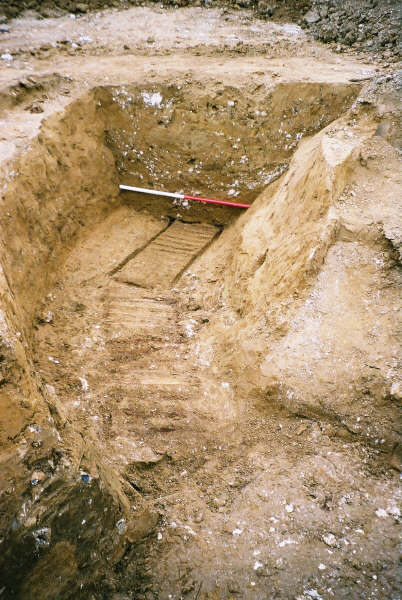
Trench boards
No Man's Land was told that no archaeological works were required at the site of the new visitor centre for the Thiepval Memorial because it was “a pulverised battlefield”. We would contest that this was over simplification of the issue. The lines around Serre were heavily contested for two years and two major battles were fought there, including use of mines and heavy weapons. This area was truly pulverised and yet the very limited works we undertook revealed a wealth of artefacts and information, as well as identifiable human remains. We also showed the state of preservation of both material and human remains, which led to a better understanding of aspects of the Great War. The message is plain. Sites of this nature should not be written off until effectively evaluated by competent archaeologists.
You Don't Get This With The Romans…
The practice of contemporary conflict archaeology is different because of proximity
and becuase of the traumatic nature of the events under examination. This raises
certain issues for the archaeologists involved. Each person came with their
own motivations and attitudes to the project and the War beyond payment and
one team member explicitly wrote the names of his missing relatives fromthe
war on his safety helmet so that his ancestors appeared on camera along side
Owen. Each reacted to events in different ways, especially to the finding of
the skeletons, for this revealed most about the team. For most the very act
of recovering the remains became a physical act of remembrance and, for several,
the presence of the worked flint made operations very personal, as we were recovering
someone who had at least a passing knowledge with archaeology; one of "our
own". This emotion might sit uneasily in a social science like archaeology
but we believe that overt acknowledgemen!t of these motivations is highly significant,
adding both value in the public mind and a personal sense of connection to the
past less tangible elsewhere. The association with Owen, that archetypal "Doomed
Youth", and the presence of human remains touched visitors deeply, excavation
of Skeleton 3 was even disrupted (in the nicest way) as a visitor scattered
geranium petals so that the wind carried them into the working area. Archaeology
touches a human desire to "know" our ancestors and here proximity
and the cultural significance of the Great War combined to add obvious meaning
to our work.
Conclusion
Guess what! We never found Owen's dugout, like much associated with war the
plan and the actuality did not coincide. The BBC did get a programme and three
of the missing, who have told us much about life in the trenches, were brought
from the soil. In doing so we demonstrated how careful, archaeological techniques
can lead to a positive identification of the fallen skeleton. Moreover an archaeological
team showed how much can be learned from one small intervention into an archaeological
site 400 miles long and 20 miles wide. By examining the minutiae of the battlefield
we are able to not only explore the process of combat in the Great War but we
are also able to see how individuals operated in an utterly alien environment.
Acknowledgements
I am indebted to the NML team for enduring dreadful conditions; on this occasion
the excavation really was like the Somme! Colonel Philip Robinson was invaluable
in connection with subterranean warfare and explosives issues. Peter Chasseaud,
Alastair Fraser and Andrew Robertshaw's knowledge of military history was vital
and Alastair, with Ralph Whitehead and Volker Hartmann gave Skeleton 1 an identity.
Arlene King of Newfoundland Park and Roy Hemmington of the Commonwealth War
Graves Commission were on hand to help us when bodies were discovered. Avril
Williams provided the vital function of feeding us. Most importantly Monsieur
Samain allowed us to undertake the work in his field and the BBC paid for it.
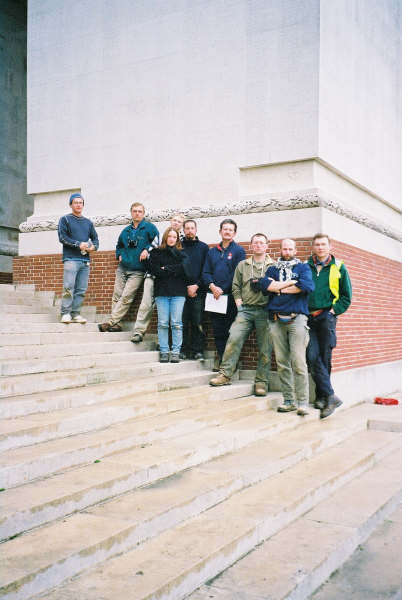
References
Fabianson, N., 2003.
http://w1.865.telia.com/~u86517080/BattlefieldArchaeology/ArkeologENG.html
Fraser, A 2004
http://www.fylde.demon.co.uk/fraser.htm
Horsfall, J., & Cave, N., 1996. Serre: Somme, Battlefield Europe, London
Hibberd, D., 2002. Wilfred Owen, a new biography, London
Saunders, N. J., 2002 "Excavating memories: archaeology and the Great War, 19142001", Antiquity, 76, 101-108
© Martin Brown, 2005
No Mans Land: The European Group for Great War Archaeology